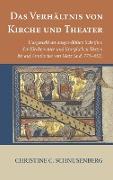Das Verhältnis von Kirche und Theater
BücherAngebote / Angebote:
This work has grown out of the question regarding the negative relationship of the Church Fathers toward the Roman theatre and the apparent subsequent theatre vacuum of over 400 years (ca. 530 AD to 930 AD). This is considered to be the time which lies between the end of the Roman theatre and the appearance of the quem quaeritis tropes. This work moves between these two poles: on the one hand, between the polemics against the pagan Roman theatre which the Church Fathers described as a theatrum daemonicum and on the other hand, the appearances of dramatic-liturgical configurations in the Christian Church. This work attempts to connect these two opposite poles instead of separating them. This study begins with an examination of documents dealing with the patristic polemic. This is followed by an examination in chronological sequence of the development of the liturgical dramatic manifestations from Jerusalem to Amalarius of Metz. It also examines the allegorical method connected with this development. In conclusion the argument is maintained that aside the theatrum daemonicum, a theatrum infictitium et sapirituale is beginning to develop. Als ehemaliger Direktor des "Institut des Sources Chretiennes" (Institut fur Christliche Quellen), an dem ich wahrend meiner funfzehnjahrigen Tatigkeit an die hundert Bande herausgegeben habe, sehe ich es als dringend an, die Arbeit von C.C. Schnusenberg, The Relationship between the Church and the Theater nicht verloren gehen zu lassen. Erstens muss das Thema der Verurteilung des antiken Theaters, vor allem des lateinischen Theaters, durch die Kirchenvater entkommen. Zweitens behandelt die Arbeit eine uberaus fesselnde Geschichte wie einen langen Bericht. Drittens zeigt sie, dass die Berichte Trager einer Heilslehre sind. Der Autorin, die eine große patristische Bildung besitzt, ist es gelungen, ein Hauptwerk des Karolingers Amalarius von Metz, den Missae expositionis Geminus codex, zur Geltung kommen zu lassen. Das Werk ist noch immer eine Fundgrube an Fakten und Kenntnissen. --Fr. Dominique Bertrand, SJ "This book deals precisely . . . with how Christian authors from patristic times through the Carolingian era conceived of the Eucharistic liturgy as the greatest possible form of drama surpassing the theatrical tradition of classical antiquity . . . an impressive dossier of patristic and early medieval quotations . . ." --Roger Reynolds, Church History. "The author has tried painstakingly to do justice to such a many-layered and vast topic . . . it seems most desirable to cultivate the interdisciplinary dialogue so that the important problems with which Schnusenberg deals, can further be clarified . . ." --H.B. Meyers, SJ, Zeitschrift F. Kath, Theologie. "This fascinating, interdisciplinary work has achieved a unique synthesis of two problematic poles: of the harsh polemics of the Church Fathers against the Roman theatre, and of the simultaneous and subsequent development of a Christian liturgical drama and theatre." --Rowman & Littlefield Christine C. Schnusenberg was born in 1928 at Gut Gewekenhorst in St. Vit-Wiedenbrueck, Germany. Subsequent to her work in the leadership of the WLL-Landjugend (rural youth) in Nord-Rhein Westfalen, she emigrated in 1958 to the USA. She enrolled at Creighton University in Omaha, Nebraska, and concluded her studies with a Bakkalaureot (BA) in 1967. Subsequently she studied at the University of Chicago in the Department of German Languages and Literature and was awarded the Magister (MA) in 1968, and in 1976 the PhD. After this, she pursued post-doctoral research in the history of religions and hermeneutic with Professors Mirce Eliade and Paul Ricoeur in the Committee on Social Thought and was employed as editorial-archival assistant by Professor Edwa
Folgt in ca. 10 Arbeitstagen
